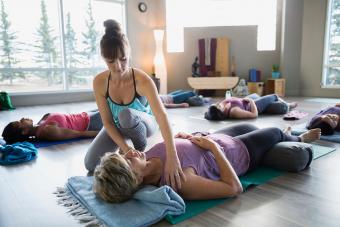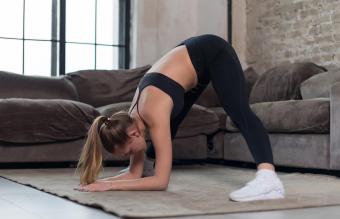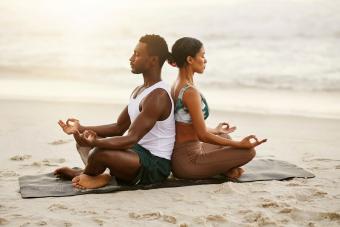
Bolsters can be used in a wide variety of yoga poses, from resting postures to supported asanas. They allow you to deeply stretch your muscles while encouraging mindfulness and relaxation. Add each pose to your practice once a week to reduce stress and increase flexibility. If you don't have a bolster, use a firm pillow instead.
Seated Postures

Since it's not uncommon to have tight hips and glutes, certain seated postures can be a challenge for many people. Using a bolster can help.
- Easy seated posture: Sitting tall with legs crossed
- Lotus: Cross-legged with your feet on top of your thighs
- Cow face pose: Crossing thighs with one knee stacked on top of the other
Lacking flexibility in these areas prevents you from being able to sit tall without constantly engaging your hip flexors, abdominals, and inner thighs. Sitting on top of a bolster will allow your knees to fall closer to the floor, taking the pressure off your hips and midsection.
Seated Forward Bends
Seated forward bends provide a great stretch for tight hamstrings, hips, and back. There are two types of seated forward bends:
- Staff pose is completed when you hinge forward at the hips with your feet together.
- Wide legged forward fold involves hinging with your feet separated as widely as possible.
These movements are simple, but can be difficult for those who lack flexibility. This is where your bolster comes in handy.
Bolster Options for Seated Forward Bends
There are two ways to use a bolster during seated forward bends.
- Place it on top of or between your legs so you can rest your forehead and torso on it.
- Sit on top of it. With your hips raised off the floor, it's easier to access your hamstrings for the stretch.
A yoga block can also be used in the second option. For best results, combine the two.
Reclined Hero's Pose
Hero's pose is a backbend that provides an intense stretch to the front line of your body, including your quads and psoas. A bolster, paired with a block or two, can make it more accessible for anyone who can't descend completely to the ground.
- Place your blocks one in front of the other so that one is at a taller height, while one is shorter.
- Place the short end of your bolster on the floor and rest the length on top of your blocks so that it creates a slope.
- Sit on your knees in front of your bolster with your hips between your feet.
- Slowly lay back against your bolster and rest with your palms facing the ceiling.
If you don't have all these props, don't worry. You can stack blankets or pillows to create the same effect.
Restorative Twist
A restorative or supported twist is a gentle posture that opens and works the muscles around the ribs and back. Because it is so relaxing, it is often recommended for people who are restless at night to combat sleeplessness.
Feet Up the Wall
Legs up the wall can be used as a resting pose to improve sleep or, for some, to gently lengthen the hamstrings. Feet up the wall is a variation that can also stretch the hips and glutes.
- Begin in legs up the wall pose, with the bolster underneath your backside.
- Bend you knees, drawing them in toward your chest.
- Bring the bottoms of your feet together and draw your knees apart.

Corpse Pose
Corpse (savasana) is the ultimate resting posture. It can help relieve hypertension and reduce headache pain. Placing a bolster underneath your knees tilts your pelvis, bringing your spine into a neutral position to release tension in your lower back.

Balance Your Practice with a Bolster
A yoga bolster can be a great compliment to your typical practice. It can make traditional poses more comfortable and accessible for yogis at any level, from beginners to advanced. If you want to make more progress with your flexibility or dial down the intensity, incorporate a bolster into your yoga practice regularly.







